
Virtual-Reality-Residenzen
im Theater im Depot
Das Theater im Depot hat ein 360°-VR-Produktionsstudio eingerichtet und plant ein Virtual-Reality-Theater mit fünfzehn Sitzplätzen. Für diesen Produktionskontext haben wir drei Produktionsresidenzen ausgeschrieben, die für Tänzer*innen und Choreograf*innen die Möglichkeit geboten haben, sich mit den Medium 360°-Film und/oder Virtual Reality auseinanderzusetzen und die Möglichkeiten zwischen diesem Medium und ihrer choreografischen Arbeit auszuloten.
Hier haben wir Eindrücke von den Residenzen versammelt: Fotos, Videos, Notizen von den Künstler*innengruppen, die uns diese auf Englisch haben zukommen lassen. Viel Spaß beim Scrollen, Lesen, Schauen und Selber-Forschen!
Residenz #1: Camila Scholtbach, Elena Tilli, Yvonne Dicketmüller
"In the first instance, we had the opportunity to connect the questions about how we will deal with near-extreme climate change and speculate that technology would allow our body to escape extinction by integrating extra functions. By accessing 360 cameras and a full-scale green screen studio, we created a virtual experience available to the audience. The experience uses the power of the camera to create a circular presence that by duplicating at first in a crescendo of multiplying figures, creates a ritual of the future based on the new ordinary movements and ‘checks’ the post-human body will do on a daily basis. The circular view of the camera inspired a cyclical and circular disposition of the subject along its path, which suits a mechanic and rhythmic repetition overall the whole choreography. Sound also participates in the research briefly by experimenting with different layers of sound recorded live from the body of the performer, such as breathing, clapping, and stumping. Later distorted and organized in a rhythmic pattern, they constitute the soundtrack of the choreography created in real-time. In parallel, research on computationally designed 3d printed costumes and applique’ the performer would integrate and use as prostheses. A second skin that helps us to adapt our bodies to life under extreme conditions."
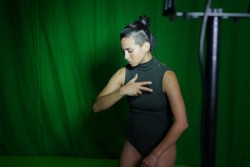
"Following two weeks in the physical space, we decided to create the first version of the experience in the 3D virtual space Mozilla Hubs, where the audience will be able to access from their computer or the public computer, free to fully navigate the space and have a sense of the progress of the work done until now. The space will also function as an archive that will store information about the process and the artist's profile. The virtual experience will be presented at Theater Im Depot in December 2022."
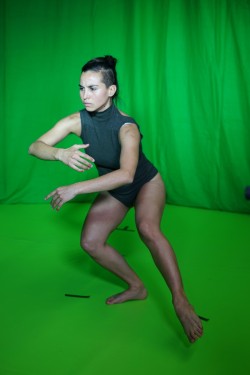
An der Residenz war maßgeblich auch Nicolás Cristancho als Künstler und Forscher beteiligt.
Residenz #2: Sara Escribano Maenza, Maria Carolina Vieira, Catalin Bocîrnea
"This project aims to further develop the piece already started in a collaboration between these artists: Sara Escribano (dance), Maria Carolina Vieira (dance-theatre) and Catalin Bocîrnea (theatre and film)."
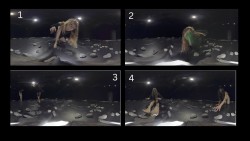
"The performer has the freedom to play with their body knowing that their image is not dependent on presence but can be projected in any space and translated into numerous forms. With the interplay of different technologies and perspectives it results in the body becoming immaterial, transforming its original form into anything, so that its movement and image are beyond the body itself. The movement is a play in between the body and the technology, where the body is a source and the technology is a translator and co-creator of the choreography. Vice-versa, the performer, understanding the readings of the technology, can be guided by the images and shapes generated by the system to compose his movement."
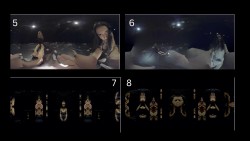
"In this sense, we explore how the two realities influence each other. We have investigated a glitch or an error not as an error of the system, but by incorporating it as part of the choreography movement. The distortion of the image is, in this sense, a creation provided by a gap in technology. The performer can provoke these errors, but the consequence on the image and the choreography is decided by the programme, or rather, by the unprogrammed. In this gap, technology brings a mysterious and uncontrolled component that relates us to the act of a live performance, where you never know what might happen and you have to respond to it in the moment."
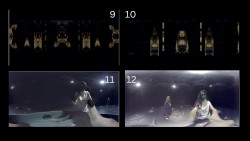
"Related to this, we would like to keep working with the concept of identity, how it can be perceived in reality and shifted in virtual reality. At the same time, we want to involve the audience in the journey. Through virtual glasses, we would like to take the audience to experience different situations thus giving them different perspectives of reality, fragmenting their body image and the space around them."
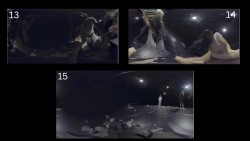
"The artistic idea is to progressively create a kaleidoscope of images. The performance starts with the image of a human body in space, gradually begins a fragmentation of this image and the body loses its usual shape. Surrounding the spectator, these images will immerse him/her in a constellation of movements, like an installation in which the spectator finds himself inside a hypnotic kaleidoscope."
Residenz #3: Norbert Pape, Simon Speiser
"Etymologically, digit finds its origin in the the latin word digitus, meaning both a fingerbreadth and a number. The latin term, in turn, stems from the Proto-Indo-European *deyǵ- (“to show, point out, pronounce solemnly”). Fingers were thus "pointers, indicators". Digit in the sense of numbers then could have followed from the fact that the same fingers used for pointing were also used for counting. Recent breakthroughs in VR / XR technology provide new means of representation that are 3 dimensional, immersive, kinetic and interactive. Quite literally, they enable us to touch and handle that which has previously been pointed out, made abstract. This folding back of touch onto abstraction provides a fertile setting for reflecting upon the nature of objects – approaching them from a phenomenological perspective while considering ethical implications in processes of objectification."
"What we have accomplished so far:
1) Our interest goes towards the question of what constitutes an object, in general and in virtual space in particular. In order to do so, we have developed techniques for displaying solely the vertices of virtual objects as so-called pointclouds.
2) We have succeeded in extending the features of hand tracking of the game engine Unity to enable detailed real time interaction of the 'user' with the depicted pointclouds: much like drawing in sand, one can use ones hands to sculpt objects in space depicted as pointclouds. Freed of controlers, the hand gestures and bodily movements resulting from the interaction with the digital world have become very refined and precise.
3) The passthrough mode of the Oculus Quest, which has recently been made accessible to gam developers, enables forms of augmented reality, in which one’s own body and surroundings are not erased, but overlaid with virtual objects. The user/spectator does not get immersed (and thereby isolated) in another world. She remains present, albeit somewhat displaced, inciting physical exploration in the augmented world."
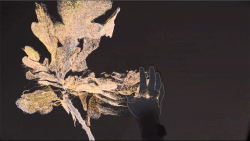
"Current aim: First experiments with these new possibilities have motivated us to create XR pieces as choreographic objects, conceived by William Forsythe as an object which transfers to the user the experiences usually reserved to a dancer, engendering an acute awareness of the self within specific action schemata. While making use of the 'magic' and sensual appeal of the technology, we want to create a work that both engages the 'user' and instigates a reflection process on the nature of this new “Guckkasten“. In particular, we intend on adressing the modes of subjectivation that the technology proposes, the limitations of the modes of interaction it offers and the ethical problems that come with 'placing' objects in a seemingly 'empty' space. The main challenges of the process will be:
understanding what dramaturgy can be in this interaction based medium with spatial extension but somewhat unforeseeable temporal unfolding
defining the set of objects that will populate the world to be built
producing a sound score and possibly voice-over that both directs the user into the experience and engages her critically with it
and last but not least, developing further extensions of the game engine Unity to enable the particular modes of interaction between movement, sound and image desired."



